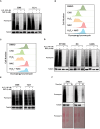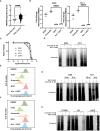Auranofin and reactive oxygen species inhibit protein synthesis and regulate the level of the PLK1 protein in Ewing sarcoma cells
- PMID: 38933441
- PMCID: PMC11199525
- DOI: 10.3389/fonc.2024.1394653
Auranofin and reactive oxygen species inhibit protein synthesis and regulate the level of the PLK1 protein in Ewing sarcoma cells
Abstract
Novel therapeutic approaches are needed for the treatment of Ewing sarcoma tumors. We previously identified that Ewing sarcoma cell lines are sensitive to drugs that inhibit protein translation. However, translational and therapeutic approaches to inhibit protein synthesis in tumors are limited. In this work, we identified that reactive oxygen species, which are generated by a wide range of chemotherapy and other drugs, inhibit protein synthesis and reduce the level of critical proteins that support tumorigenesis in Ewing sarcoma cells. In particular, we identified that both hydrogen peroxide and auranofin, an inhibitor of thioredoxin reductase and regulator of oxidative stress and reactive oxygen species, activate the repressor of protein translation 4E-BP1 and reduce the levels of the oncogenic proteins RRM2 and PLK1 in Ewing and other sarcoma cell lines. These results provide novel insight into the mechanism of how ROS-inducing drugs target cancer cells via inhibition of protein translation and identify a mechanistic link between ROS and the DNA replication (RRM2) and cell cycle regulatory (PLK1) pathways.
Keywords: 4E-BP1; RRM2; auranofin; plk1; protein synthesis; reactive oxygen species.
Copyright © 2024 Haight, Koppenhafer, Geary and Gordon.
Conflict of interest statement
The authors declare that the research was conducted in the absence of any commercial or financial relationships that could be construed as a potential conflict of interest.
Figures





Update of
-
Auranofin and reactive oxygen species inhibit protein synthesis and regulate the level of the PLK1 protein in Ewing sarcoma cells.bioRxiv [Preprint]. 2024 May 15:2024.05.13.593567. doi: 10.1101/2024.05.13.593567. bioRxiv. 2024. Update in: Front Oncol. 2024 Jun 12;14:1394653. doi: 10.3389/fonc.2024.1394653 PMID: 38798568 Free PMC article. Updated. Preprint.
Similar articles
-
Auranofin and reactive oxygen species inhibit protein synthesis and regulate the level of the PLK1 protein in Ewing sarcoma cells.bioRxiv [Preprint]. 2024 May 15:2024.05.13.593567. doi: 10.1101/2024.05.13.593567. bioRxiv. 2024. Update in: Front Oncol. 2024 Jun 12;14:1394653. doi: 10.3389/fonc.2024.1394653 PMID: 38798568 Free PMC article. Updated. Preprint.
-
The translational repressor 4E-BP1 regulates RRM2 levels and functions as a tumor suppressor in Ewing sarcoma tumors.Oncogene. 2021 Jan;40(3):564-577. doi: 10.1038/s41388-020-01552-0. Epub 2020 Nov 15. Oncogene. 2021. PMID: 33191406 Free PMC article.
-
mTORC1/2 and Protein Translation Regulate Levels of CHK1 and the Sensitivity to CHK1 Inhibitors in Ewing Sarcoma Cells.Mol Cancer Ther. 2018 Dec;17(12):2676-2688. doi: 10.1158/1535-7163.MCT-18-0260. Epub 2018 Oct 3. Mol Cancer Ther. 2018. PMID: 30282812 Free PMC article.
-
Exploiting Replication Stress as a Novel Therapeutic Intervention.Mol Cancer Res. 2021 Feb;19(2):192-206. doi: 10.1158/1541-7786.MCR-20-0651. Epub 2020 Oct 5. Mol Cancer Res. 2021. PMID: 33020173 Free PMC article. Review.
-
Multiple Roles of PLK1 in Mitosis and Meiosis.Cells. 2023 Jan 2;12(1):187. doi: 10.3390/cells12010187. Cells. 2023. PMID: 36611980 Free PMC article. Review.
References
-
- Womer RB, West DC, Krailo MD, Dickman PS, Pawel BR, Grier HE, et al. . Randomized controlled trial of interval-compressed chemotherapy for the treatment of localized Ewing sarcoma: a report from the Children’s Oncology Group. J Clin Oncol. (2012) 30:4148–54. doi: 10.1200/JCO.2011.41.5703 - DOI - PMC - PubMed
-
- Leavey PJ, Laack NN, Krailo MD, Buxton A, Randall RL, DuBois SG, et al. . Phase III trial adding vincristine-topotecan-cyclophosphamide to the initial treatment of patients with nonmetastatic ewing sarcoma: A children’s oncology group report. J Clin Oncol. (2021) 39:4029–38. doi: 10.1200/JCO.21.00358 - DOI - PMC - PubMed
Grants and funding
LinkOut - more resources
Full Text Sources
Miscellaneous

